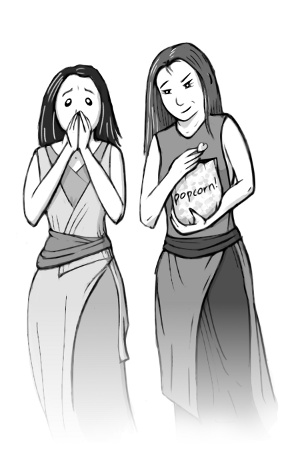Many thanks to Tristan Morris for creating a beautiful illustrated hardcover print edition of the site

 |
|
 |
 |
 |
|
 | |
 | |
It happened that two monks of the Laughing Monkey Clan were quarreling at such volume in the Great Hall that they had attracted an audience.
“If I wish to know a customer’s billing address,” said the first monk, “then Customer should have a getBillingAddress method, just as it has getName! How can you reject the elegance of my design?”
“Because your method silently loads the address from the database!” countered the second. “That is not the Pattern for Value Objects! They exist only to contain the data fetched by a DAO. You should have an AddressDAO for querying the Address table, fronted by a Service method. The billing address should be obtained directly from there.”
“But we have lost the Way of Object-Orientation!” shouted the first. “Have we come full circle back to the days of C? Our Value Objects are little more than structs, our stateless DAOs and Services are merely collections of related functions, and we pass around integer IDs instead of the objects they represent! Shall we next run about on all fours and bay at the moon?”

“The Way of Enterprise Design Patterns is an advancement towards ideal simplicity, not a regression to the primitive!” said the second. “A domain object is not intended to work as its namesake, any more than a picture of a shovel is meant to dig a ditch! You must set aside appearances and focus on purpose!”
“Purpose is inherent in the name chosen!” said the first. “Domain objects should model the real world!”
The second monk responded with a fist to the first monk’s stomach, doubling him up. “Tell me,” said the second monk, “in which instance variable did I hit you?”
The first monk leapt forward and boxed his opponent’s ears. “And here I thought those appendanges were for listening!” said the first, as the second staggered aside in pain. “How fortunate that I set aside appearances and discovered their true purpose!” His gloating was cut short by an uppercut to the jaw.
A young nun—a novice—noticed that several of the Java masters were at the edge of the crowd, silently watching the proceedings. She ran to them.
“The two monks will kill each other before long!” said the novice. “Why do you not settle their dispute and tell us which philosophy is superior?”
The masters ignored her. But the nun Zjing heard, and whispered to the novice:
“If I were the monk who prefers the Way of Enterprise Design Patterns, I would say that you have committed the same error as the ditch-digger. There is a question to be settled, but you have mistaken the purposes of those present.”
“Are you saying that the masters intend to conceal the answer from us?” asked the novice.
“Wú,” said Zjing. “If I were the monk who prefers the Way of Object-Orientation, I would call your attention to the Unwritten Hierarchy, in which Master is but a subclass of Student.”
An excerpt from The Codeless Code, by Qi (qi@thecodelesscode.com).
Provided under the Creative Commons Attribution-NonCommercial 3.0 Unported License.














